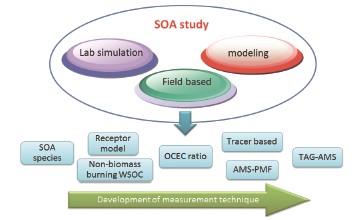化学学报 ›› 2014, Vol. 72 ›› Issue (2): 145-157.DOI: 10.6023/A13111169 上一篇 下一篇
综述
郭松, 胡敏, 尚冬杰, 郭庆丰, 胡伟伟
Guo Song, Hu Min, Shang Dongjie, Guo Qingfeng, Hu Weiwei

二次有机气溶胶(SOA)是指挥发性有机物在大气中发生光化学氧化进入到颗粒相的产物,由于其具有强烈的环境效应、气候效应和人体健康效应,因此成为大气化学研究的热点. 然而由于SOA的复杂性和测量技术的限制,目前对SOA的研究还非常有限. 总体来说,对SOA的研究手段主要有三种方法:实验室模拟、模式模拟和基于外场观测的SOA研究. 由于SOA的研究非常广泛,本文仅综述了基于外场观测的SOA组成、来源和生成机制的研究,重点在于SOA组分的测量和总量的估算. 基于外场观测的SOA研究是随着技术的发展而发展的,早期的研究仅仅能对SOA的少数物种进行测量,主要是一些有机酸和多羟基化合物;也有利用一些假设对SOA进行粗略的估算,如受体模型法、非生物质燃烧水溶性有机物法;随着SOA实验室模拟研究和示踪物测量技术的发展,二次有机示踪物法真正做到了对特定前体物VOC生成SOA的估算;随着在线测量技术的提高,EC示踪/CO示踪和OC/EC比值法和基于气溶胶质谱(AMS)-正交矩阵模型(PMF)的方法被广泛应用于SOA的估算. 尤其是AMS-PMF联用方法的出现为SOA来源和生成机制的研究开拓了新的方向. 对AMS技术和示踪物技术的进一步联合和开发有望成为未来SOA研究重要的方向.